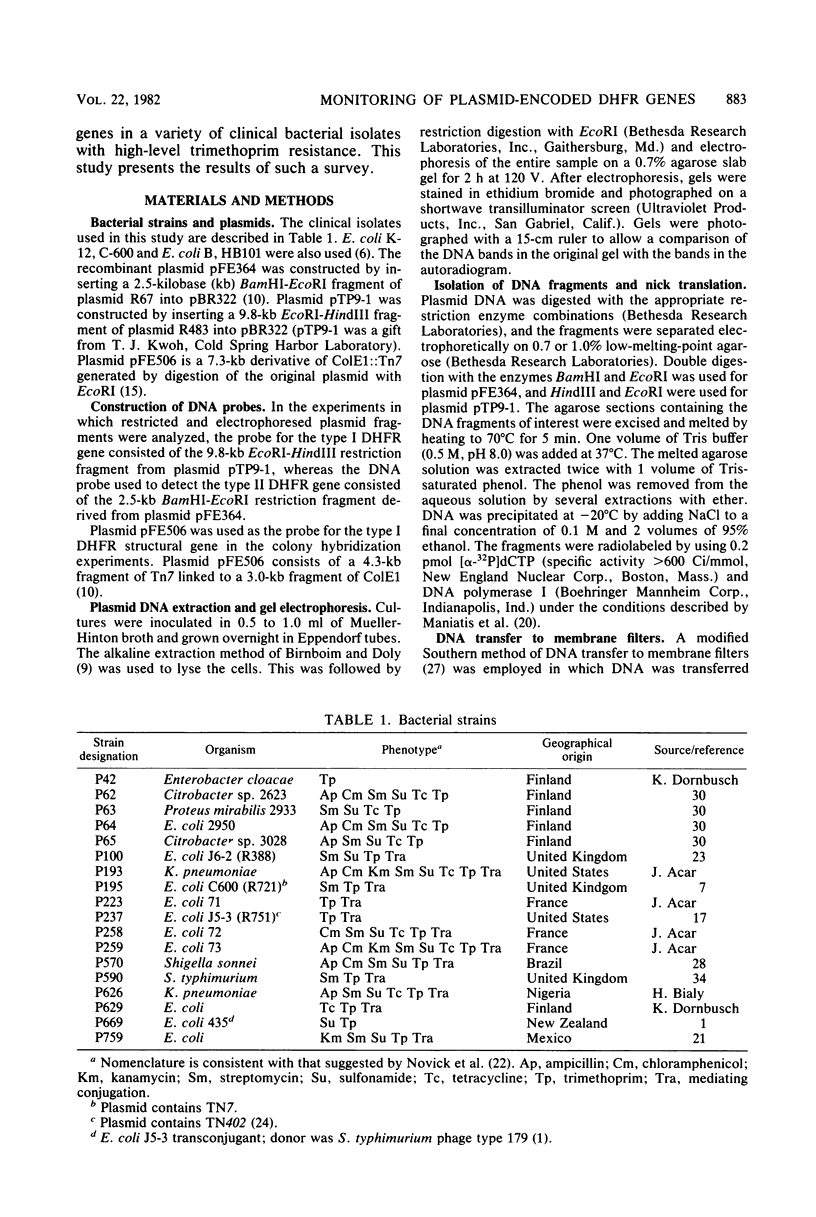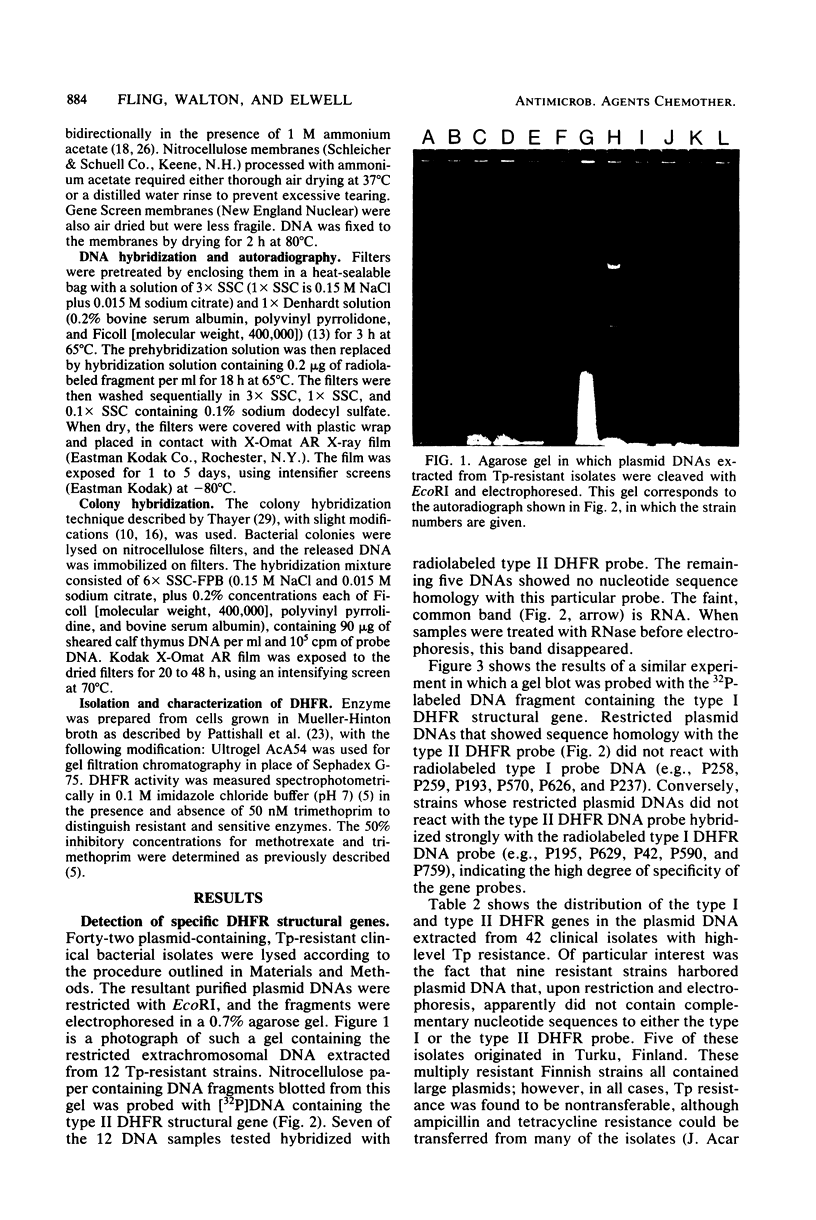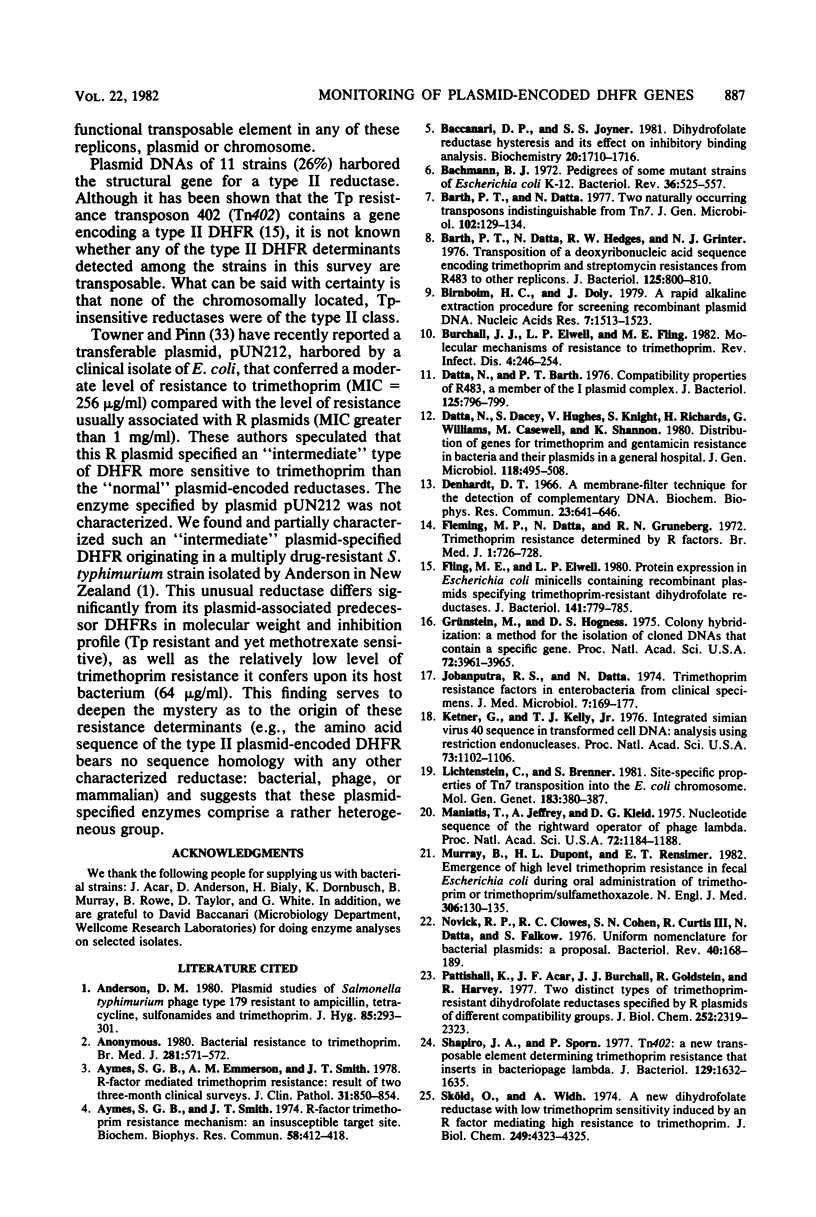Abstract
Using-gene-specific radiolabeled probe DNAs, we analyzed 42 clinical bacterial isolates with high-level trimethoprim (Tp) resistance for the presence of a type I or a type II plasmid-specified dihydrofolate reductase (DHFR) gene. Plasmid DNA from 17 strains harbored a type I DHFR, whereas 11 isolates contained plasmids that harbored a type II DHFR structural gene. The plasmid DNAs from five strains appeared to hybridize with both type I and type II DHFR probe DNAs. In addition, eight isolates had type I resistance determinants integrated into the chromosomes, presumably on transposon 7 (Tn7). Among the strains analyzed in this survey, none of the chromosomally located, Tp-insensitive reductases were of the type II class. Both the plasmid and chromosomal DNAs of one isolate showed no homology with either the type I or type II DHFR probe DNA. The plasmid harbored by this strain encoded a "new" Tp-resistant enzyme that differed significantly, both in molecular weight and with respect to trimethoprim and methotrexate inhibition kinetics, from the previously characterized plasmid-associated dihydrofolate reductases.
Full text
PDF






Images in this article
Selected References
These references are in PubMed. This may not be the complete list of references from this article.
- Amyes S. G., Emmerson A. M., Smith J. T. R-factor mediated trimethoprim resistance: result of two three-month clinical surveys. J Clin Pathol. 1978 Sep;31(9):850–854. doi: 10.1136/jcp.31.9.850. [DOI] [PMC free article] [PubMed] [Google Scholar]
- Amyes S. G., Smith J. T. R-factor trimethoprim resistance mechanism: an insusceptible target site. Biochem Biophys Res Commun. 1974 May 20;58(2):412–418. doi: 10.1016/0006-291x(74)90380-5. [DOI] [PubMed] [Google Scholar]
- Anderson D. M. Plasmid studies of Salmonella typhimurium phage type 179 resistant to ampicillin, tetracycline, sulphonamides and trimethoprim. J Hyg (Lond) 1980 Oct;85(2):293–300. doi: 10.1017/s0022172400063336. [DOI] [PMC free article] [PubMed] [Google Scholar]
- Baccanari D. P., Joyner S. S. Dihydrofolate reductase hysteresis and its effect of inhibitor binding analyses. Biochemistry. 1981 Mar 31;20(7):1710–1716. doi: 10.1021/bi00510a002. [DOI] [PubMed] [Google Scholar]
- Bachmann B. J. Pedigrees of some mutant strains of Escherichia coli K-12. Bacteriol Rev. 1972 Dec;36(4):525–557. doi: 10.1128/br.36.4.525-557.1972. [DOI] [PMC free article] [PubMed] [Google Scholar]
- Barth P. T., Datta N., Hedges R. W., Grinter N. J. Transposition of a deoxyribonucleic acid sequence encoding trimethoprim and streptomycin resistances from R483 to other replicons. J Bacteriol. 1976 Mar;125(3):800–810. doi: 10.1128/jb.125.3.800-810.1976. [DOI] [PMC free article] [PubMed] [Google Scholar]
- Barth P. T., Datta N. Two naturally occurring transposons indistinguishable from Tn7. J Gen Microbiol. 1977 Sep;102(1):129–134. doi: 10.1099/00221287-102-1-129. [DOI] [PubMed] [Google Scholar]
- Birnboim H. C., Doly J. A rapid alkaline extraction procedure for screening recombinant plasmid DNA. Nucleic Acids Res. 1979 Nov 24;7(6):1513–1523. doi: 10.1093/nar/7.6.1513. [DOI] [PMC free article] [PubMed] [Google Scholar]
- Burchall J. J., Elwell L. P., Fling M. E. Molecular mechanisms of resistance to trimethoprim. Rev Infect Dis. 1982 Mar-Apr;4(2):246–254. doi: 10.1093/clinids/4.2.246. [DOI] [PubMed] [Google Scholar]
- Datta N., Barth P. T. Compatibility properties of R483, a member of the I plasmid complex. J Bacteriol. 1976 Mar;125(3):796–799. doi: 10.1128/jb.125.3.796-799.1976. [DOI] [PMC free article] [PubMed] [Google Scholar]
- Datta N., Dacey S., Hughes V., Knight S., Richards H., Williams G., Casewell M., Shannon K. P. Distribution of genes for trimethoprim and gentamicin resistance in bacteria and their plasmids in a general hospital. J Gen Microbiol. 1980 Jun;118(2):495–508. doi: 10.1099/00221287-118-2-495. [DOI] [PubMed] [Google Scholar]
- Denhardt D. T. A membrane-filter technique for the detection of complementary DNA. Biochem Biophys Res Commun. 1966 Jun 13;23(5):641–646. doi: 10.1016/0006-291x(66)90447-5. [DOI] [PubMed] [Google Scholar]
- Fleming M. P., Datta N., Grüneberg R. N. Trimethoprim resistance determined by R factors. Br Med J. 1972 Mar 18;1(5802):726–728. doi: 10.1136/bmj.1.5802.726. [DOI] [PMC free article] [PubMed] [Google Scholar]
- Fling M. E., Elwell L. P. Protein expression in Escherichia coli minicells containing recombinant plasmids specifying trimethoprim-resistant dihydrofolate reductases. J Bacteriol. 1980 Feb;141(2):779–785. doi: 10.1128/jb.141.2.779-785.1980. [DOI] [PMC free article] [PubMed] [Google Scholar]
- Grunstein M., Hogness D. S. Colony hybridization: a method for the isolation of cloned DNAs that contain a specific gene. Proc Natl Acad Sci U S A. 1975 Oct;72(10):3961–3965. doi: 10.1073/pnas.72.10.3961. [DOI] [PMC free article] [PubMed] [Google Scholar]
- Jobanputra R. S., Datta N. Trimethoprim R factors in enterobacteria from clinical specimens. J Med Microbiol. 1974 May;7(2):169–177. doi: 10.1099/00222615-7-2-169. [DOI] [PubMed] [Google Scholar]
- Ketner G., Kelly T. J., Jr Integrated simian virus 40 sequences in transformed cell DNA: analysis using restriction endonucleases. Proc Natl Acad Sci U S A. 1976 Apr;73(4):1102–1106. doi: 10.1073/pnas.73.4.1102. [DOI] [PMC free article] [PubMed] [Google Scholar]
- Lichtenstein C., Brenner S. Site-specific properties of Tn7 transposition into the E. coli chromosome. Mol Gen Genet. 1981;183(2):380–387. doi: 10.1007/BF00270644. [DOI] [PubMed] [Google Scholar]
- Maniatis T., Jeffrey A., Kleid D. G. Nucleotide sequence of the rightward operator of phage lambda. Proc Natl Acad Sci U S A. 1975 Mar;72(3):1184–1188. doi: 10.1073/pnas.72.3.1184. [DOI] [PMC free article] [PubMed] [Google Scholar]
- Murray B. E., Rensimer E. R., DuPont H. L. Emergence of high-level trimethoprim resistance in fecal Escherichia coli during oral administration of trimethoprim or trimethoprim--sulfamethoxazole. N Engl J Med. 1982 Jan 21;306(3):130–135. doi: 10.1056/NEJM198201213060302. [DOI] [PubMed] [Google Scholar]
- Novick R. P., Clowes R. C., Cohen S. N., Curtiss R., 3rd, Datta N., Falkow S. Uniform nomenclature for bacterial plasmids: a proposal. Bacteriol Rev. 1976 Mar;40(1):168–189. doi: 10.1128/br.40.1.168-189.1976. [DOI] [PMC free article] [PubMed] [Google Scholar]
- Pattishall K. H., Acar J., Burchall J. J., Goldstein F. W., Harvey R. J. Two distinct types of trimethoprim-resistant dihydrofolate reductase specified by R-plasmids of different compatibility groups. J Biol Chem. 1977 Apr 10;252(7):2319–2323. [PubMed] [Google Scholar]
- Shapiro J. A., Sporn P. Tn402: a new transposable element determining trimethoprim resistance that inserts in bacteriophage lambda. J Bacteriol. 1977 Mar;129(3):1632–1635. doi: 10.1128/jb.129.3.1632-1635.1977. [DOI] [PMC free article] [PubMed] [Google Scholar]
- Smith G. E., Summers M. D. The bidirectional transfer of DNA and RNA to nitrocellulose or diazobenzyloxymethyl-paper. Anal Biochem. 1980 Nov 15;109(1):123–129. doi: 10.1016/0003-2697(80)90019-6. [DOI] [PubMed] [Google Scholar]
- Southern E. M. Detection of specific sequences among DNA fragments separated by gel electrophoresis. J Mol Biol. 1975 Nov 5;98(3):503–517. doi: 10.1016/s0022-2836(75)80083-0. [DOI] [PubMed] [Google Scholar]
- Taylor D. E., Keystone J. S., Devlin H. R. Resistance to trimethoprim and other antibiotics in Ontario shigellae. Lancet. 1980 Feb 23;1(8165):426–426. [PubMed] [Google Scholar]
- Thayer R. E. An improved method for detecting foreign DNA in plasmids of Escherichia coli. Anal Biochem. 1979 Sep 15;98(1):60–63. doi: 10.1016/0003-2697(79)90705-x. [DOI] [PubMed] [Google Scholar]
- Then R. L., Hermann F. Mechanisms of trimethoprim resistance in enterobacteria isolated in Finland. Chemotherapy. 1981;27(3):192–199. doi: 10.1159/000237977. [DOI] [PubMed] [Google Scholar]
- Threlfall E. J., Ward L. R., Ashley A. S., Rowe B. Plasmid-encoded trimethoprim resistance in multiresistant epidemic Salmonella typhimurium phage types 204 and 193 in Britain. Br Med J. 1980 May 17;280(6225):1210–1211. doi: 10.1136/bmj.280.6225.1210. [DOI] [PMC free article] [PubMed] [Google Scholar]
- Towner K. J. A clinical isolate of Escherichia coli owing its trimethoprim resistance to a chromosomally-located trimethoprim transposon. J Antimicrob Chemother. 1981 Feb;7(2):157–162. doi: 10.1093/jac/7.2.157. [DOI] [PubMed] [Google Scholar]
- Towner K. J., Pearson N. J., Pinn P. A., O'Grady F. Increasing importance of plasmid-mediated trimethoprim resistance in enterobacteria: two six-month clinical surveys. Br Med J. 1980 Feb 23;280(6213):517–519. doi: 10.1136/bmj.280.6213.517. [DOI] [PMC free article] [PubMed] [Google Scholar]
- Wilson J. M., Guiney D. G. Failure of oral trimethoprim-sulfamethoxazole prophylaxis in acute leukemia: isolation of resistant plasmids from strains of Enterobacteriaceae causing bacteremia. N Engl J Med. 1982 Jan 7;306(1):16–20. doi: 10.1056/NEJM198201073060105. [DOI] [PubMed] [Google Scholar]






